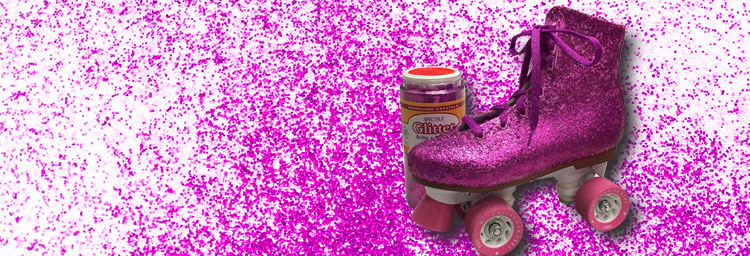Last winter, Anita Yavich, the Costume Designer for the Huntington Theatre Company’s production of Molière’s “Tartuffe,” needed a pair of hot pink, glitter roller skates. Keeping with the updated translation by Ranjit Bolt, the character of Marianne would be wearing a pink and black bespangled Dolce and Gabanna dress; and she would enter the scene on those glittered roller skates. When she heard about the idea for the design, Costume Artist, Denise Wallace-Spriggs, knew they would not be able to buy such spectacular things “off-the-rack," so she began doing some test samples to see how they could create the bespoke skates themselves. Denise tells her story below.
As many costumers know, glittered items can be the gift that keeps on giving, in that if the glitter is not properly bonded to the costume it tends to flake off and it will shed its glory upon anything in its path. For The Colored Museum at The Huntington (also a Yavich design), I used Rosco FlexBond to help seal the glitter onto a pair of platform boots that came pre-glittered. I chose to use Flexbond in that case because the glitter was on the boot already and it needed a very light, thin application, which would also be flexible.
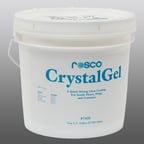 For the Tartuffe roller skate project, I determined that I wanted to use Rosco CrystalGel. In my testing, I saw that I could embed the glitter into the gel and that it had the sticking power I would need since it will stick to practically anything! Also, CrystalGel is very flexible, which I knew would be important to the comfort of Sarah Oakes Muirhead, the actress playing Marianne.
For the Tartuffe roller skate project, I determined that I wanted to use Rosco CrystalGel. In my testing, I saw that I could embed the glitter into the gel and that it had the sticking power I would need since it will stick to practically anything! Also, CrystalGel is very flexible, which I knew would be important to the comfort of Sarah Oakes Muirhead, the actress playing Marianne.
 We began with a pair of white leather skates with bright pink wheels. To prep the surface under the glitter coat, I added some hot pink shoe dye into the CrystalGel. Using this method of coloring instead of using paint keeps the gel clear and unclouded. You can also use powdered dyes or inks for this purpose, but it is best to paste the dry ones up in some water first.
We began with a pair of white leather skates with bright pink wheels. To prep the surface under the glitter coat, I added some hot pink shoe dye into the CrystalGel. Using this method of coloring instead of using paint keeps the gel clear and unclouded. You can also use powdered dyes or inks for this purpose, but it is best to paste the dry ones up in some water first.
I taped off the parts of the skates that we didn’t want to be glittered with masking tape, and then I painted a coat of the pink CrystalGel onto the white leather.
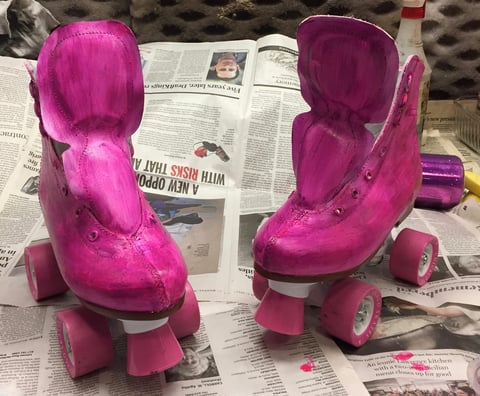 Skates with undercoat mixture of CrystalGel and hot pink shoe dye
Skates with undercoat mixture of CrystalGel and hot pink shoe dye
It is important at this stage to remove the tape so that you can clean up any CrystalGel that may have seeped under the tape while it is still wet. If you try to pull it up after it dries, you can end up pulling up more than you bargained for.
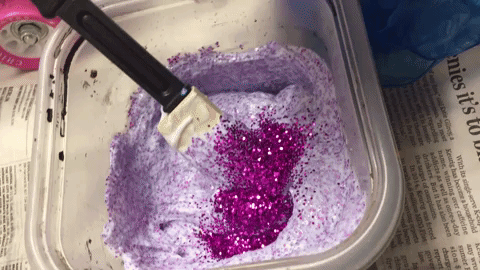
Once the undercoat dried, I re-taped the boot and set about making the glitter gel. I ran some tests to find the right size of glitter particle to use. The micro-fine glitter was shiny, but not glittery enough and it would not flash the stage lighting in the preferred way. In the end, we went for the standard size, or “Brilliant” glitter by Spectra brand in the magenta color. By adding the glitter directly into the CrystalGel we could avoid any of the usual flaking off that you get when you apply glitter over the top of glue. The fact that CrystalGel dries so clear makes it possible to see every bit of the shine and flash without worrying about rub-off. I added a bit of glitter at a time to the pink gel to find the right ratio of glitter to gel.
PRO-TIP: Since glitter is simply fine particles of plastic with a metallic finish, making it prone to picking up a static charge, it should be noted here that I use a very careful protocol when using glitter in my craft shop that I call “Glitter Mitigation.” One thing that crafters should concern themselves with in this day and age is micro-fine plastics use and its effect on ocean life. In order to prevent dumping the glitter into the trash (and thereby having it end up in the ocean), or having it spread all over the workshop, I place newspaper under my project and spray it with water to slightly dampen it. This treatment helps to catch any spilled glitter and trap it on the newspaper. When the paper dries, I can crease it and pour the excess glitter back into the container.
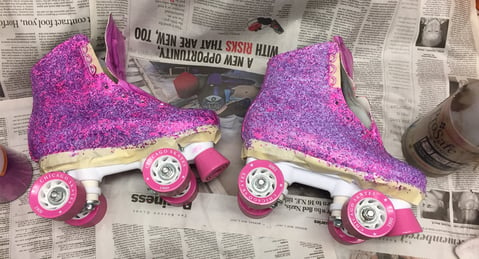 After the first application of our CrystalGel/Glitter mixture
After the first application of our CrystalGel/Glitter mixture
Once the desired ratio of glitter to gel was achieved, I used a small silicone spatula to apply the first coat of glittered gel to the boot. Great care was taken to avoid getting glitter on the loops and eyelets where the lacings were to go through, as once the CrystalGel was dry, any of the particles of the glitter that stuck out of the gel would act like small knives that would cut the laces, making speed lacing impossible in the quick change situation backstage.
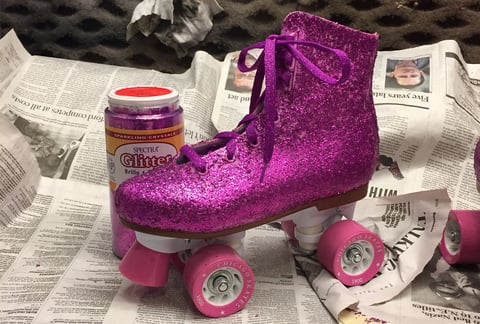 Second coat of CrystalGel/glitter mixture really made the skates sparkle
Second coat of CrystalGel/glitter mixture really made the skates sparkle
The boots required two coats of the glitter mixture to achieve the desired effect. I allowed them to dry overnight between coats since some of the coated surfaces were in deep crevices and would take a while to fully dry. After the second coat was applied and dried, all that was needed was a pair of hot pink Mylar laces and Marianne would be ready to skate across the Huntington stage in style.
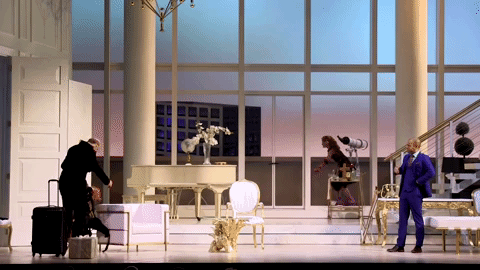
Denise Wallace-Spriggs is a Massachusetts-based costume crafts artisan and has been an integral part of the production team at the Huntington Theatre Company in Boston for almost 30 years. Ms Wallace-Spriggs also has an excellent reputation as a teacher. She is currently a Lecturer at Boston University and she hosts workshops on many craft subjects in her studio in Stoughton, MA and all over the country. To explore more of her work or check on her list of upcoming workshops, visit her website: denisewallacespriggs.com or follow her Facebook page. To learn more about the product Denise used to durably attach glitter to her "Tartuffe Roller Skates," visit the Rosco CrystalGel web page. Finally, if you’d like to learn more about the costumes designed for Huntington Theatre Company’s production of "Tartuffe" – watch the video below:

